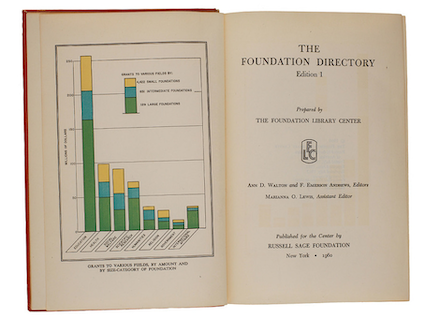Giving in America: A look at philanthropy’s history and a unique Candid connection

About a month ago, Candid was tagged in a social media post from someone who had visited the Smithsonian’s National Museum of American History. Specifically, they saw the exhibition Giving in America, which includes one of the first copies of Foundation Directory. We loved seeing this unique piece of our past and wanted to learn more about the object and exhibition.
We reached out to Amanda Moniz, Ph.D., the David M. Rubenstein Curator of Philanthropy at the Smithsonian’s National Museum of American History. Amanda’s role is to build a collection of objects telling stories about Americans’ giving throughout our history. She also curates Giving in America, conducts research on the history of philanthropy, and participates in programs such as their Power of Giving symposium and special programs like Stories of Black Philanthropy: Treasures from the National Museum of American History.
Can you give a little bit of background on the exhibition Giving in America?
In 2015, the Smithsonian’s National Museum of American History launched the Philanthropy Initiative to collect, document, research, and create exhibitions and online content relating to the history of American giving. We also convene conversations with historic perspectives about philanthropy’s impact across a wide spectrum of issues. Giving in America opened on Giving Tuesday 2016.
Part of the exhibit is organized around the questions of who gives, why do we give, how do we give, and what do we give, while another thematic section changes annually. The current thematic section, “Who Pays for Education?,” examines Americans’ debates over public and philanthropic funding for education. Over the past few years, the exhibit has included objects such as the mop bucket used by Jeanette Senerchia in helping to launch the ALS Ice Bucket Challenge, a UNICEF trick-or-treat collection box, Sesame Street Muppets, a bust of Andrew Carnegie, and a carved wooden turtle that Ford Foundation president Darren Walker kept on his desk—just to name a few! We also always feature a selection of Giving Pledge letters in conversation with the objects in the thematic section. The wide range of objects help show that the United States has been shaped and reshaped by the giving of everyday philanthropists, grassroots organizations, major institutions, prominent benefactors, and fundraising and philanthropy industry professionals.
Can you tell us about the Foundation Directory book? Why is it important to this history?
The book featured in the exhibition is a first edition of the Foundation Directory, published by the Foundation Center Library in 1960, and generously donated to the national Philanthropy collection by the Foundation Center. It is a terrific object because it helps illuminate the creation of the Foundation Center to bring greater transparency to foundations’ work in response to mid-twentieth century congressional scrutiny of foundations’ power. The book is also important because it reminds us of the ways people accessed information on foundations before the advent of the internet.
I love the Foundation Directory because, in addition to shedding light on earlier generations’ suspicions about foundations, the book helps visitors understand the people and institutions who provide the infrastructure in the United States’s robust philanthropy sector. Visitors may be less familiar with the history of the people who do the hard work of raising money and making the philanthropy industry function, so I’m keen on collecting objects that reflect the innovations, turning points, and notable developments among professionals in fundraising and philanthropy.
Funny story: Right before we were putting the book on exhibit, the Foundation Center and GuideStar merged to become Candid. We had to update the object label for the exhibit at the last moment to reflect the new name of the organization.
If people want to learn more, online or in-person, where can they go?
Please check out the online version of the exhibit, or if you’re in DC, you’ll find the exhibit on the third floor of the National Museum of American History in the center of the building. You can also explore a range of blog posts, program videos, and more at the Philanthropy Initiative website.
Curious about Foundation Directory’s evolution? Check out what it looks like today.







